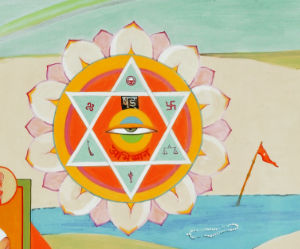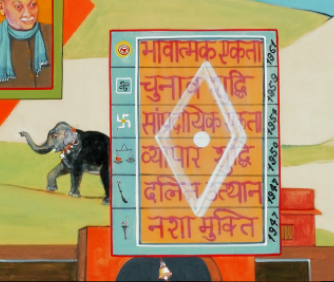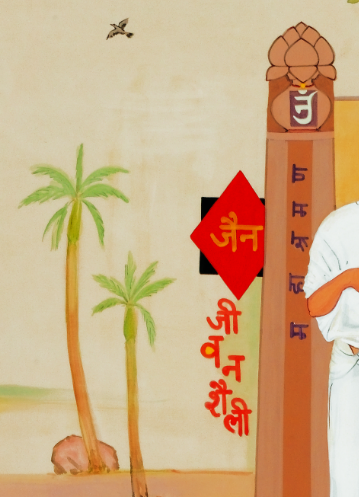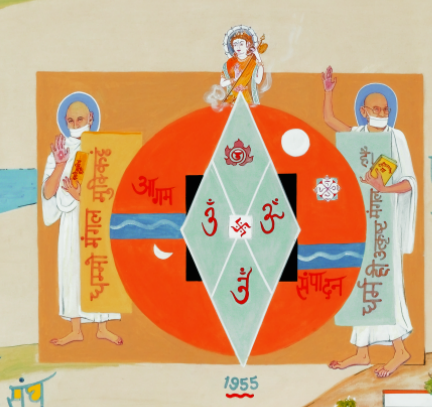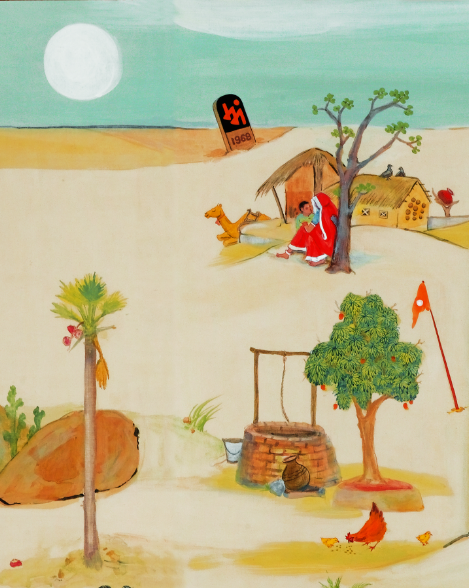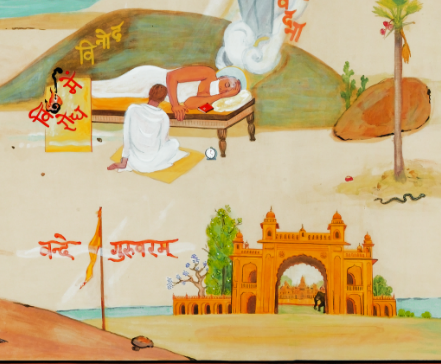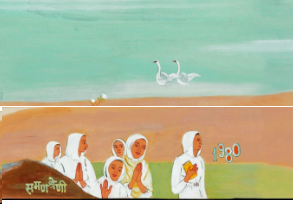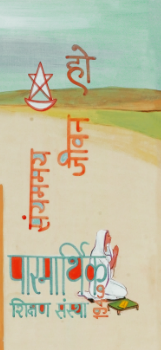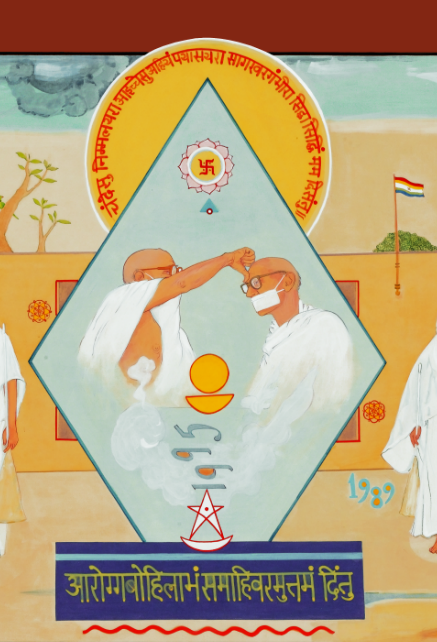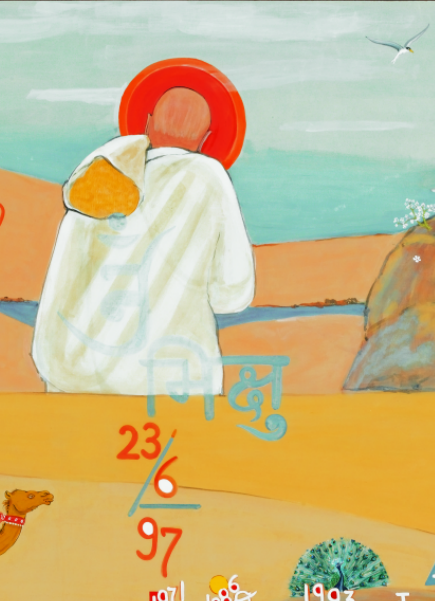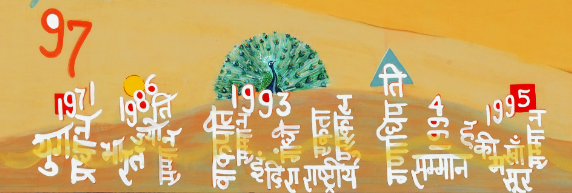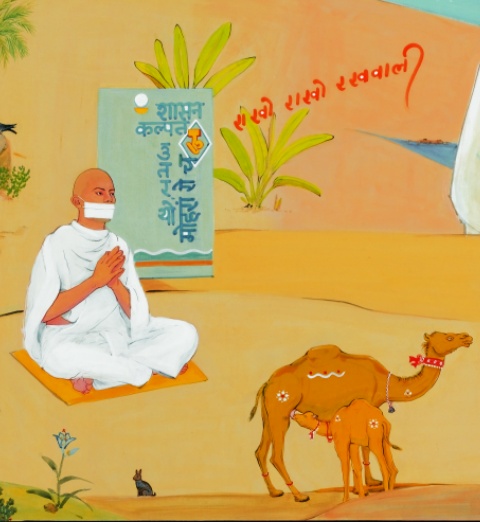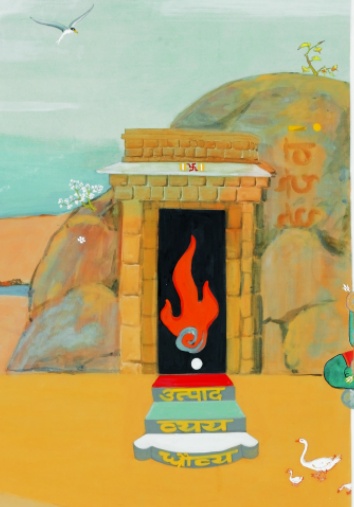

Acharya Tulsi International Conference Miami
Lecture, 02.12.2014
Introduction
We have gathered here today to throw light upon Acharya Sri Tulsi's modern and futuristic approach to Jainism, but, I would like to begin my discourse with a flashback, going back to the 1920's
A time when religion was synonymous with the mere practice of rituals
A time when morals were freely compromised for personal gains
A time when the youth were estranged from all things spiritual
A time when women were victims of a Patriarchal society
A time when preaching was limited to the Marwari dialect
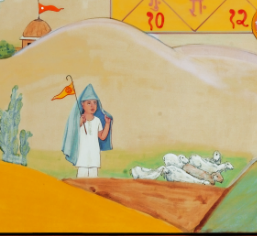
Snapshot from Panel 1
The “herd mentality” of these individuals required a gifted “shepherd boy” that could lead them not just to the nearest meadows, but to their inner spiritual self.
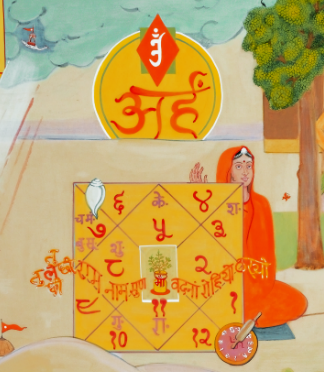
Snapshot from Panel 1
The much awaited leader was born to Mother Vadana in 1914 in Ladnun (Rajasthan) and it undoubtedly marks the rising of a glorious sun for the Jain Terapanth sect.
Mural Biography
As a painter, I cherished the desire to unfold the holy biography of Acharya Tulsi on canvas. But, while working I realised that a single canvas was not sufficient to highlight his exceptional achievements. Thus the canvas turned into a mural of seven continuous boards, 56 feet in length and 4 feet in height. Just as the thread of breath that starts from birth and continues until death, without pausing for a moment, in the same way, the long continuous mural illustrates Acharya Tulsi’s life journey from his mother’s womb to his worldly demise. The mural has been painted on cloth using Earth colours in Indian style of painting, a few samples of which have been kept on display.
In my humble effort as an artist to paint the biography of this revered Holy Soul, I have come closer to his life, teachings and achievements. I will briefly touch upon his role in modernising Jainism as a religious guru, Social Reformer, and Sangh Leader
A. His role as the Religious Guru
Acharya Tulsi’s role as a religious Guru was not limited to the Terapnath Jain sect or to the practice of Jain rituals. His belief that “good conduct is true religion” (1) inspired people across the Globe and gave way to a “Universal religion”.
I. Spiritual awakening through the principles of Anuvrat
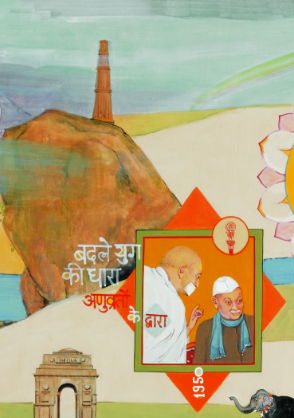
Snapshot from Panel 3
Acharya Tulsi outlined that religion has two manifestations, the primary one being behavioural and the second less significant one being rituals. Unfortunately over time rituals have gained importance and faith has been replaced by fear (2). Hence, he introduced a non-sectarian movement called Anuvrat to provide a moral framework for a better life. Acharya Tulsi took the initiative to move out of Rajasthan and meet dignitaries in Delhi to explain the importance of the Movement.
Snapshot from Panel 3Its key principles called Shad-Abhiyana have been painted symbolically in a shad-chakra (hexagonal cycle) placed within a lotus, which stands as a symbol of purity (4). Spearheading such a revolutionary movement, requires the awakening of the inner eye, and has been illustrated in the centre of the chakra. The blue hemisphere above the eye denotes the sky and green below it denotes the Earth, together emphasising its broad perspective and reach (5). The fluttering flag and floating garland beside the chakra suggest that the movement was praiseworthy.
Snapshot from Panel 3
The six-elements of the campaign include: unity of feeling, purity of election, unity of sects, honesty in business, upliftment of dalits or lower classes, and freedom from addiction. These were initiated over a span of time and the respective years have been painted. The elephant on the left symbolises the campaign’s wide appeal (6), and the ringing bell below it resounds its broad reach.
II. Making religious beliefs a part of everyday Lifestyle; Jain Jeevan Shaili
Snapshot from Panel 6The Jain Jivan Shaili or "Jain style of living" was introduced in 1989 with the objective of making religious beliefs a part of everyday life. Since these principles support and strengthen the day-to-day life of every Jain, it has been scripted beside a pillar in the 6th panel of the painting.
III. Driving spiritual growth through Jivan Vigyan and Preksha Dhyan
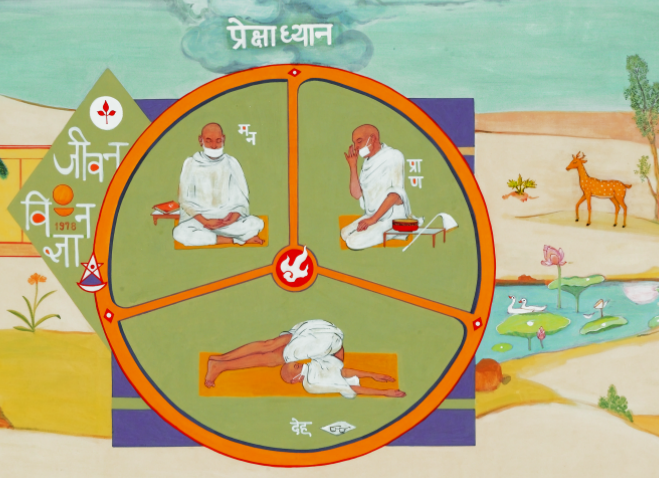
Snapshot from Panel 6
Being a pragmatic leader, He realised that the principles of Anuvrat, though noble, may be difficult to practise in isolation. In order to maintain self-restrain, it is necessary to bring together the body, mind and soul (7). Thus, he suggested Muni Nathmal (later known as Acharya Mahapragya) to research and develop meditation techniques from the Jain tradition that blended well with modern human psychology. These meditation techniques were later coined as Preksha Dhyan. "Preksha" is a way to perceive oneself, using one’s breath, psychic centres, and sensations (8). The discovery of Preksha Dhyan has revitalized the ancient practice of Jain Sadhna that was almost forgotten.
Muni Nathmal also gave shape to the “Science of Life” or Jivan Vigyan, through texts and discourses (9). He has been shown in 3 segments, practicing 'Meditation', 'Pranayam' and 'Yoga' for the realisation of the bliss of solitude which has been suggested by the imaginative presentation of a naturally restless deer. The image of 2 swans floating quietly beside a lotus flower represents gentlemen that are free of attachment and harness their internal energies to experience peace (10).
IV. Literary initiatives
Snapshot from Panel 3Acharya Sri Tulsi is shown holding the old book Dasvealiyam Suttam, the first line of which ‘dhamo mangal mukkittham' (Religion is the ultimate good) is boldly painted in original Prakrit language. Then there is muni Nathmal holding the newly edited copy of Dasvaikalika Sutra with its first line boldly painted in Hindi, “dharma hi utkrishta mangal hai'. Between them there is a saffron circle, with the illustration of Shruta devi, Saraswati without whose blessings such wisdom is difficult to attain. The circle includes a 4 faced conch shell (11) as if it were announcing the commencement of a noble task. The waves in blue suggest the time taken in editing the treatise, as it is still an ongoing process. Moreover, a light blue diamond has 'Om' written in four different styles; Adi Om, Shaiva Om, Jain Om, Vishnu Om again emphasizing this literary initiative that made age-old wisdom accessible to new-age followers in their language of comfort.
V. Jain Vishva Bharti for the advancement of Jain studies
Snapshot from Panel 6
His vision of a unique University dedicated to the advancement of Jain studies was realised by the establishment of the Jain Vishva Bharti in Ladnun, Rajasthan in 1970. The peacock being a symbol of knowledge and learning (12) is shown perched upon the main entrance of the University, in Panel 6 of the painting. A fruit tree (13) is illustrated on the right hand side, symbolising the fruitfulness of the endeavour. Its “yield” can be measured by the several PG and PhD degree programmes as well as short-term courses that the University offers. Being the world's first Jain University, it has played a vital role in educating Saman Shrenis, Mumukshu sisters and common man (14).
B. His role as a Social Reformer
In Acharya Sri Tulsi's view, the role of a religious leader is not confined to spiritual growth, but permeates into the cultural and moral practices of the society at large. “Sudhare vyakti, samaj vyakti se rashtra swayam sudharega” is an excerpt from one of his songs that expresses his ideology of transforming the nation by starting the transformation at the individual level. It is almost like a banyan tree that grows from a small sapling to a large tree supported by its tendrils (15).
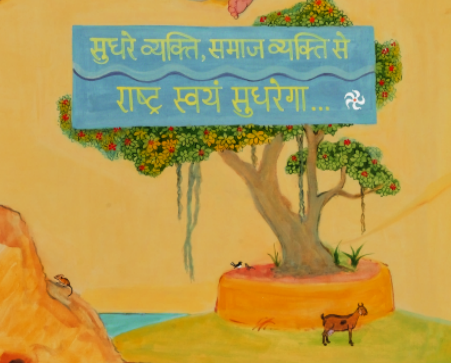
Snapshot from Panel 6
I. Empowering Women
Snapshot from Panel 5
In my painting I have illustrated a woman sitting beside her hut, with her son on her lap, as though she is restricted to her domesticity. A part of the lady's face is covered by her sari and is suggestive of the parda system that was widely opposed by Acharya Tulsi (16). The landscape of the rural household is complete with a well and a domesticated hen, who is also engrossed in feeding and looking after her chicks. Realizing that the potential of women far exceeds that of domesticated hens, he initiated several programs to tap their inert potential and lead them to empowerment (17). A black milestone with the Mahila Mandal logo inscribed on it has been placed outside the boundary of the lady's home suggesting that it provided an opportunity for them to step out of confinement (18). Programs such as Acharya Tulsi Siksha Pariyojana, and Acharya Kalu Kanya Mahavidyala were also initiated to provide primary education to women.
II. Uplifting the Oppressed (lower) Classes
As mentioned earlier, the dominance of casteism and the problems of the oppressed classes were paralyzing the society and he proposed to do away with these irrationalities through the Anuvrat Movement (19).
III. Shravak Sangh

Snapshot from Panel 5
He believed that shravak or devotees form an integral part of a Dharama Sangh or religious sect and if they can be organised into a formal structure their efforts would yield greater results (20). Acharya Tulsi's efforts have today resulted in 13 organizations with a web of several sub-organizations that are working under the umbrella of Akhil Bhartiya Terapanth Mahasabha (21). The painting highlights the logo of the Tearapanth Yuvak Parishad that was established in Bikaner in 1964 with the motto of service, dedication, and organization (22).
Snapshot from Panel 4
His moral revolution attracted a lot of opposition that was largely fuelled by anger and hence depicted by fire in Panel 4 of the painting. Gurudev has been shown lying down peacefully, even in the midst of assault by stones and violent aggression. A snake is shown swishing away, suggesting the idea that venom disappears in the presence of sacredness. Although he faced opposition, there was no dearth of followers that supported his efforts and welcomed him with the words "Vande Guruvaram". The fluttering flag beside the slogan is symbolic of the several hearts he won by his persistent efforts.
He transformed the era, bringing society out of a narrow outlook and enabled it to keep pace with the modern and in fact post-modern world. He tried to unify the distorted parts of human society and hemmed them out to make it complete and square (23).
C. His role as the Sangh Guru
As the 9th Acharya of the Terapanth Sangh, he undertook several measures to keep pace with the changing times without compromising the basic tenants of Jainism.
I. Saman Shreni
Snapshot from Panel 5Acharya Tulsi realized that the principles of modern Jainism could not cross national boundaries with the restrictive traditional guidelines applicable for Sadhus and Sadhvis (24). At the same time he was mindful of the importance of the existing practices and refrained from changing them (25). Hence he initiated a new, intermediate category of Jain Ascetics in 1980, called the "Saman Shreni". These spiritual practitioners depicted as two white birds have fewer restrictions and can fly across seas and oceans to spread the teachings of Lord Mahavira.
The transformation, though radical was the need of the hour and this congregation here in Florida, thousands of miles away from India, stands to exemplify the vision of His Holiness.
II. Spiritual Training Institute
Snapshot from panel 3
A spiritual training Institute called the Parmarthik Shikshan Sanstha was founded in 1949 for the training of young girls and women (or Mumukshus) who wish to enter monkhood. Along with formal education they are given opportunities to practise meditation, learn Jain Philosophy, and ancient languages (26).
A mumukshu sister in Namaskar mudra and beside her an illustration of a five angled star has been shown symbolising the five senses and the moon suggesting our mind (27). The mumukshu sister desiring to step into monkhood needs to restrain her senses and the mind from going astray. "Sanyamamay Jivan Ho" (A life restrained) is an extract from a popular song written by Acharya Tulsi and preaches self-discipline not only to mumukshu sisters but to the society at large.
III. Encouraging education and advancement of Sadhvis
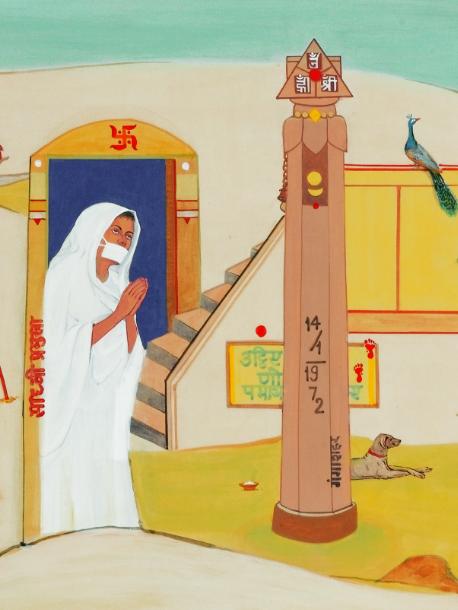
Snapshot from Panel 5
There was an obvious disparity between the education of monks and nuns at that time and Acharya Tulsi decided to provide nuns an equal footing (28). A young sadhvi has been illustrated standing beside a flight of stairs, implying the progress towards both intellectual and spiritual ends. The words "Utthiye no pamaye" or "once awakened, never be mistaken" is a call for advancement of mind and soul. He laid the foundation for a robust educational infrastructure and is suggested by the pillar beside the staircase.
IV. Leading by example
Acharya Tulsi was not just a torch bearer, but a source of light himself. His unconventional actions are a lesson by themselves, one such being the historic renunciation of Acharyahood in 1995. I have shown him ceremoniously handing over the Acharya pada to his successor, Yuvacharya Mahapragya. Along with renouncing his position, he also showered his blessings on Yuvacharya Mahapragya and has been imaginatively shown by rain clouds that bring showers and nurture the Earth.
Snapshot from Panel 6
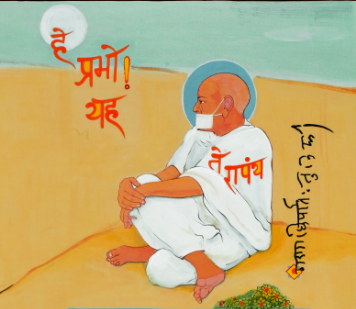
Snapshot from Panel 6He intended to free himself of all responsibilities so that he could devote time to spreading the message of non-violence and spirituality (29). Sitting down on bare sand in a relaxed position, he conveyed several significant messages
Conclusion
Snapshot from panel 7
For a living legend, death is merely a fact of mortality. The depiction of Acharya Tulsi walking towards the setting sun, and a bird spreading its wings to travel to its next destination, imaginatively implies the physical end of a glorious life (31). A life he led, as the 9th Terapanth Acharya, but with the enduring presence of its first Acharya (Bhikshu). The words "Om Bhikshu" have been merged into the illustration, symbolically suggesting its inseparable existence throughout his life.
Though 23rd June, 1997 marks the passing away of a great Acharya, there is no sign of fear, remorse or grief. For noble souls like him, death is to be welcomed when it comes. That is precisely why I have shown a dancing peacock at the lower end.
Snapshot from panel 7
For some people, life is measured by the awards and accolades won in the lifetime. Although Acharya Tulsi received much recognition such as Indira Gandhi National Unity Award, Bharat Jyoti Samman, to name a few, I feel that this is an insufficient yardstick.
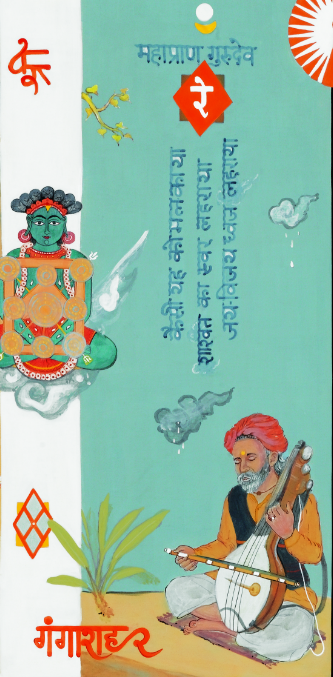
Snapshot from panel 7
For others, life is summed up by the hearts touched and love received, and in this respect too, he emerged a winner. His teachings, principles and affection reached out to innumerable followers, irrespective of caste, creed or social status. Here I have painted a folk musician singing the farewell song composed by Acharya Mahapragya and it seems to affect the entire surroundings, the tear-shedding clouds as well as the simple musician engrossed in his act. I have
also been greatly influenced by Acharya Tulsi on a personal level and as an artist I felt compelled to give his words of wisdom a tangible form. Some of my original works illustrating his quotes have also been exhibited here.
Snapshot from panel 7
For a few, life is measured by the legacy left behind, and the provisions made for dear ones. Much before leaving for his heavenly abode, he left the Sangh in the able guidance of his successor, Acharya Mahapragya, who was then succeeded by Acharya Mahashraman. Acharya Tulsi’s presence in spite of bodily absence is so pervasive that I have shown it imaginatively, through the life-sustaining intimacy between a milch-camel and its young one drawing milk. His nourishing presence is felt by everyone attached to the sect, directly or indirectly. The organizations, projects and other endeavors initiated by him, continue to exist and prosper, keeping his memory and efforts alive.
Snapshot from panel 7
However, for me, as a humble devotee, Acharya Tulsi's life was a living example of a core Jain philosophy, or if I may say, the essence of all Jain treaties. He personifies the universal truth of “Utpad” (Origination) “Vyaya” (cessation), and “Dhrauvya” (existence), which I have presented by three flames inside a cave. These flames must not be misunderstood as those of a funeral pyre, but deconstructed into its three distinct colours; red for Utpad, blue for Vyaya, and white for Dhrauvya. Birth or origination and death or cessation is a worldly reality that no one can refute (32); but for me and thousands of others, Acharya Tulsi continues to exist. His teachings and spiritual philosophy have stood the test of time and will continue to touch and change lives for years to come.
References
- Sadhvi Vishrut Vibha, Acharya Shri Tulsi-A Legend of Humanity, Acharya Tulsi Janma Shatabdi Samaroha Samiti, 2013, p. 43
- Acharya Tulsi, Atit ka Visarjan Anagat ka swagat, Adarsh Sahitya Sangha, p.25
- Prof. Dr. M. K. Bhandar, Dr.Kuldeep Singh Panwar, The Anuvrat: Origin, Vision and Evolution of Movement, Tulsi Prajna, Jain Vishwa Bharati Institute, July December 2013, Vol 158-159, p.225-227
- Dr. Gopal Madhukar Chaturvedi, Bhartiya Chitrakala, Sahitya Sangam, 1989, p. 113
- Kapila Vatsyayan (Chief ed.), Kala Tattva Kosh IV, 1999, p. 63
- Dr. Gopal Madhukar Chaturvedi, Bhartiya Chitrakala, p. 117
- Acharya Tulsi, Atit ka Visarjan Anagat ka swagat, p.28
- Sadhvi Vishrut Vibha, Acharya Shree Tulsi- A Legend of Humanity, p. 53-54
- Acharya Shri Tulsi, Vichar Vithi, Adarsh Sahitya Sangha, p. 175
- Shobhanath Pathak, Bhartiya Sanskritik Prateek Kosh, Pramat Prakashan, 1999, p.55
- Dr. Gopal Madhukar Chaturvedi, Bhartiya Chitrakala, p. 118
- Padmasri Prabha Shankar Ojha, Bhartiya Shilpa Samhita, p. 25
- Dr. Gopal Madhukar Chaturvedi, Bhartiya Chitrakala, p.112
- Sadhvi Vishrut Vibha, Acharya Shree Tulsi- A Legend of Humanity, p. 68
- A Dictionary of Symbols Philosophical Library, New York, 1962, p.332
- Acharya Tulsi, Atit ka Visarjan Anagat ka swagat, p.156
- Babagrahi Pradhan, Dr. Vishnu Kumar, Women Education and the Speculation of Acharya Tulsi: A view, Tulsi Prajna, Vol. 158-159, p. 295
- Acharya Tulsi, A Peacemaker par Excellence, 34-35, Tulsi Prajna, Vol. 158-159, p. 255
- Acharya Tulsi, Clarian Call of Anuvrat, Tulsi Prajna, Vol. 158-159, p 254
- Acharya Tulsi, Jab Jago, Tabhi Savera, Adarsh Sahitya Sangha, p.184
- Dr. Samani Ramaniya Pragya, Achaarya Tulsi: A Mass Healer of the Century, Tulsi Prajna, Vol. 158-159, p.257-258
- Yuvacharya Mahapragya, Dharmachakra ka Pravartan, Amrit Mahotsav Rashtriya Samiti, 1986, p.278
- Acharya Mahapragya, Tulsi Vichar Darshan, Jain Vishwa Bharati, p.49
- Yuvacharya Mahapragya, Dharmachakra ka Pravartan, 1986, p.279
- Acharya Tulsi, Atit ka Visarjan Anagat ka swagat, Adarsh Sahitya Sangha, p.57
- Yuvacharya Mahapragya, Dharmachakra ka Pravartan, 1986, p.213
- R.V. X. 90, 13-14
- Acharya Shree Tulsi, Vichar Vithi, Adarsh Sahitya Sangha, p.173
- Sadhvi Vishrut Vibha, Acharya Shri Tulsi- A Legend of Humanity, p.94
- ibid, p.92
- Dr. Gopal Madhukar Chaturvedi, Bhartiya Chitrakala, Sahitya Sangam, 1989, p.111
- R. V., I.164.20, 19
 Dr. Manju Nahata
Dr. Manju Nahata
